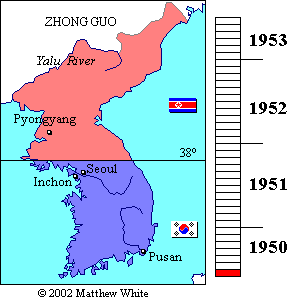
The Korean War was much less of a battle between two conflicting peoples, but rather two larger nations holding the strings of mannequins. Both sides of Korea were intent on removing the 38th parallel, the line dividing North and South Korea, and reuniting as a single country. But on the larger world stage, the United States and Soviet Unions had their own ideas in mind. The United States did not want to see all of Korea united in communism, while the Soviets were determined not to become neighbors with a democratic nation. These contrasting motivations shattered the Korean hopes of union, and the 38th parallel remained with the United States occupying the South and the Soviet Union holding the North.
By June 1950, a fresh 5 years after WWII, North Korea finally took action and crossed the 38th parallel into the Republic of South Korea, heading for the capital city of Seoul. Within three days, the successful advance had cut through the majority of unprepared South Korea, and had routed most of the resistance by July 4th. The UN response was immediate, calling for the "immediate cessation of hostilities." When North Korea failed to acknowledge the resolution, the UN placed America as leader of UN forces to aid South Korea. Truman dedicated all of the American armed forces to battle the North Koreans, and on July 8th, General Douglas MacArthur was appointed. The tide had turned.
By September 15th, the American entrance to the war was complete. The American counterattack, beginning with a daring landing at Incheon, proved extremely effective. MacArthur pursued the North Koreans and drove the back almost as quickly as they had come, capturing the North Korean capital of Pyongyang. However, MacArthur's overconfidence led to another turning point in the war. As he continued routing North Korean forces despite the warnings and orders from Truman to cease, the invasion drew closer and closer to China. The Chinese were disgruntled and intimidated by the assault, and as an effect, 300,000 Chinese joined the war on the North Korean side.
The Chinese counterattack marked the end of UN advances, and pushed MacArthur back across the 38th parallel until he was back on the bottom of South Korea. Seoul changed hands for a third time. Nevertheless, the UN reorganization and retaliation eventually drove the fighting back to the 38th parallel. After months of heavy fighting, the two opposing sides were virtually in the same exact position they had started at, where it remained for the rest of the war.
At this point, MacArthur wished to pursue the North Koreans and drive them back into North Korea. Truman, however, saw the dangers of continuing the fight and ordered MacArthur to hold his ground. Finally, on the recommendation of Joint Chiefs of Staff, Truman removed MacArthur from command for continual criticism of the U.S. Foreign Policy.
Throughout the next two years, negotions broke down almost four times before succeeding. An armistic was signed on July 27, 1953, after the loss of 54,000 American lives with 103,000 wounded. Chinese and North Korean losses amounted to almost ten times as many as the Americans.
And such was the cost of crossing the line.

By Victor and Brandon
Very creative title! Extremely informative also and not the McCarthy witch hunt like all the others =).
ReplyDeleteWow! You guys wrote a lot! There were many interesting facts. I like how you guys ended the blog with "and such was the cost of crossing the line." Very original
ReplyDeleteThanks guys!
ReplyDeleteGOOD JOB!! I agree. You guys this was really thorough and you had good information. =]
ReplyDeleteThe picture really helps me to see how the division of land changed in North and South Korea.
ReplyDeleteIt was very well written. Also, the picture was really cool and helpful. Good job.
ReplyDeleteThe graphics were so helpful and made everything really easy to understand. This was definately one of the best articles I've read. It was very well written and origional.
ReplyDeleteThe animation at the start really sums up your article. It was totally above and beyond all requirements. The text was extremely detailed and all the pictures had a purpose. Great Job!
ReplyDelete-Greg
The writing is very engaging and flows well. You did a good job explaining everything.
ReplyDeleteThis article is a prime example of what all bloggers should strive for. It contains mounds upon mounds of detailed information, as well as a helpful animation to go along with the text. Very well done.
ReplyDelete